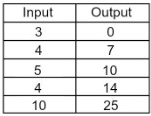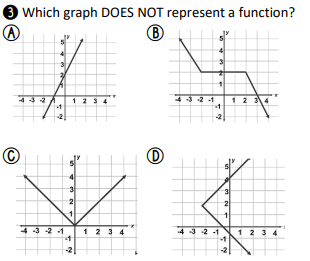What is the coefficient in the expression 7x + 4?
A. 4
B. 7
C. x
D. 11
B. 7
Which symbol represents "greater than or equal to"?
A. >
B. <
C. ≥
D. ≤
C. ≥
In the formula A = lw, what does “w” represent?
A. Area
B. Width
C. Weight
D. Length
B. Width
Which of the following best describes a function?
A. One input can have many outputs
B. Inputs and outputs must be equal
C. Each input has exactly one output
D. Outputs repeat, but inputs do not
C. Each input has exactly one output
Function A: A taxi charges a flat fee of $5 and $2 per mile.
Function B: y=3x
Which function has a higher rate of change?
A. Function A
B. Function B
C. They have the same rate of change
D. Not enough information
B. Function B
Which expression represents “5 less than three times a number x”?
A. 5 – 3x
B. 3x – 5
C. 5x – 3
D. 3 – 5x
B. 3x – 5
Ashley wants to save at least $100. She already has $40. If she saves $10 per week, which inequality shows how many weeks (w) it will take her to meet her goal?
A. 10w + 40 < 100
B. 10w + 40 ≥ 100
C. 40 – 10w ≥ 100
D. 10w ≥ 100
B. 10w + 40 ≥ 100
Solve the formula A = bh for b.
A. b = A – h
B. b = A + h
C. b = A ÷ h
D. b = A × h
b = A ÷ h
Is this table a function?

A. Yes, because all outputs are different
B. No, because the input 4 has more than one output
C. Yes, because the input values are all numbers
D. No, because the table has five rows
B. No, because the input 4 has more than one output
Function A (Table):

Function B: y=3x+1
Which function has the greater initial value?
A. Function A
B. Function B
C. Both are equal
D. Cannot determine
A. Function A (initial value is 4; B’s is 1)
Solve: 4(x – 2) = 2x + 6
A. x = 7
B. x = 2
C. x = –7
D. x = 6
A. x = 7
Solve: x – 5 > 12
A. x > 7
B. x > 17
C. x < 7
D. x < 17
x > 17
Solve for h in the formula A = ½bh.
A. h = A ÷ b
B. h = 2A ÷ b
C. h = b ÷ A
D. h = ½A ÷ b
B. h = 2A ÷ b
Which set of ordered pairs represents a function?
A. {(1, 2), (1, 3), (2, 4)}
B. {(0, 0), (2, 1), (4, 2)}
C. {(5, 1), (5, 2), (6, 3)}
D. {(3, 7), (3, 7), (3, 8)}
B. {(0, 0), (2, 1), (4, 2)}
Function A: Graphed line passes through (0, 2) and (2, 6)
Function B: y=2x+4
Which function has the greater rate of change?
A. Function A
B. Function B
C. Same rate
D. Not enough info
A. Function A
What is the solution to the equation 2x + 3 = 2x – 5?
A. x = –4
B. No solution
C. x = 4
D. Infinite solutions
B. No solution
Solve: 3(x + 2) ≤ 18
A. x ≤ 4
B. x ≥ 4
C. x ≤ 5
D. x ≥ 5
A. x ≤ 4
Solve for y: 3x – 4y = 12
A. y = ¾x – 3
B. y = –¾x + 3
C. y = (3x + 12)/4
D. y = (3x – 12)/4
B. y = –¾x + 3

D
Function A (Table):

Function B: Starts at $5 and increases by $2 each day.
Which function has the greater rate of change?
A. Function A
B. Function B
C. Same rate
D. Not enough info
A. Function A
Which step is justified by the Distributive Property in solving the equation 3(x – 4) = 2x + 1?
A. Subtracting 2x from both sides
B. Multiplying both sides by 3
C. Rewriting 3(x – 4) as 3x – 12
D. Adding 4 to both sides
C. Rewriting 3(x – 4) as 3x – 12
Solve the compound inequality:
–3 < 2x – 1 ≤ 5
A. –1 < x ≤ 3
B. 2 < x ≤ 4
C. –2 < x < 3
D. –1 ≤ x < 2
–1 < x ≤ 3
Solve for r: V = πr²h
A. r = √(V/πh)
B. r = V/πh
C. r = V²/πh
D. r = √(πh/V)
A. r = √(V/πh)
You are given the rule: “2x - 3.” Which output corresponds to an input of 5?
A. 10
B. 8
C. 7
D. –1
C. 7
Function A: A graph shows a line starting at (0, 4) and passing through (2, 10).
Function B (Table):

Which function has the greater initial value and rate of change?
A. Function A has greater initial value and rate
B. Function B has greater initial value and rate
C. Function A has greater initial value; B has greater rate
D. Function B has greater initial value; A has greater rate
C. Function A has greater initial value (4 vs. 3); B has greater rate (4 vs. 3)